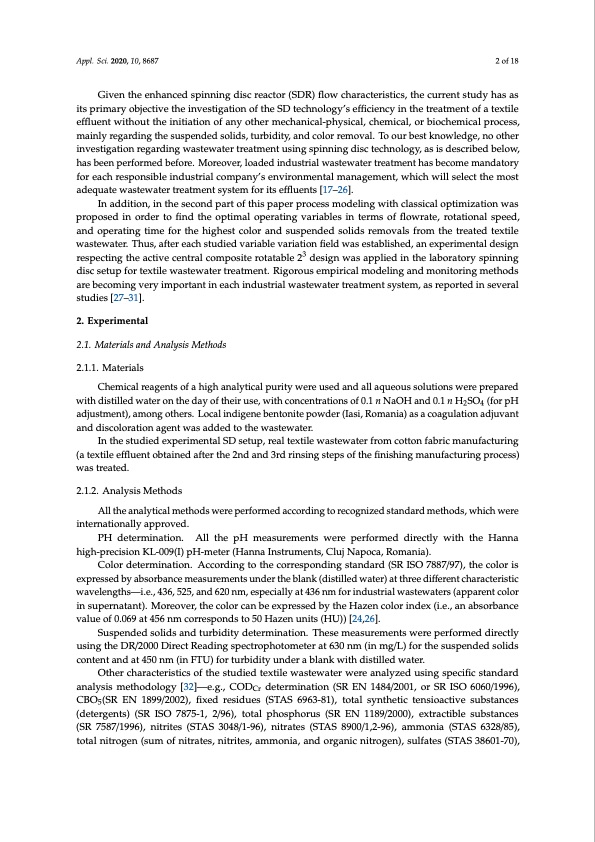
PDF Publication Title:
Text from PDF Page: 002
Appl. Sci. 2020, 10, 8687 2 of 18 Given the enhanced spinning disc reactor (SDR) flow characteristics, the current study has as its primary objective the investigation of the SD technology’s efficiency in the treatment of a textile effluent without the initiation of any other mechanical-physical, chemical, or biochemical process, mainly regarding the suspended solids, turbidity, and color removal. To our best knowledge, no other investigation regarding wastewater treatment using spinning disc technology, as is described below, has been performed before. Moreover, loaded industrial wastewater treatment has become mandatory for each responsible industrial company’s environmental management, which will select the most adequate wastewater treatment system for its effluents [17–26]. In addition, in the second part of this paper process modeling with classical optimization was proposed in order to find the optimal operating variables in terms of flowrate, rotational speed, and operating time for the highest color and suspended solids removals from the treated textile wastewater. Thus, after each studied variable variation field was established, an experimental design respecting the active central composite rotatable 23 design was applied in the laboratory spinning disc setup for textile wastewater treatment. Rigorous empirical modeling and monitoring methods are becoming very important in each industrial wastewater treatment system, as reported in several studies [27–31]. 2. Experimental 2.1. Materials and Analysis Methods 2.1.1. Materials Chemical reagents of a high analytical purity were used and all aqueous solutions were prepared with distilled water on the day of their use, with concentrations of 0.1 n NaOH and 0.1 n H2SO4 (for pH adjustment), among others. Local indigene bentonite powder (Iasi, Romania) as a coagulation adjuvant and discoloration agent was added to the wastewater. In the studied experimental SD setup, real textile wastewater from cotton fabric manufacturing (a textile effluent obtained after the 2nd and 3rd rinsing steps of the finishing manufacturing process) was treated. 2.1.2. Analysis Methods All the analytical methods were performed according to recognized standard methods, which were internationally approved. PH determination. All the pH measurements were performed directly with the Hanna high-precision KL-009(I) pH-meter (Hanna Instruments, Cluj Napoca, Romania). Color determination. According to the corresponding standard (SR ISO 7887/97), the color is expressed by absorbance measurements under the blank (distilled water) at three different characteristic wavelengths—i.e., 436, 525, and 620 nm, especially at 436 nm for industrial wastewaters (apparent color in supernatant). Moreover, the color can be expressed by the Hazen color index (i.e., an absorbance value of 0.069 at 456 nm corresponds to 50 Hazen units (HU)) [24,26]. Suspended solids and turbidity determination. These measurements were performed directly using the DR/2000 Direct Reading spectrophotometer at 630 nm (in mg/L) for the suspended solids content and at 450 nm (in FTU) for turbidity under a blank with distilled water. Other characteristics of the studied textile wastewater were analyzed using specific standard analysis methodology [32]—e.g., CODCr determination (SR EN 1484/2001, or SR ISO 6060/1996), CBO5(SR EN 1899/2002), fixed residues (STAS 6963-81), total synthetic tensioactive substances (detergents) (SR ISO 7875-1, 2/96), total phosphorus (SR EN 1189/2000), extractible substances (SR 7587/1996), nitrites (STAS 3048/1-96), nitrates (STAS 8900/1,2-96), ammonia (STAS 6328/85), total nitrogen (sum of nitrates, nitrites, ammonia, and organic nitrogen), sulfates (STAS 38601-70),PDF Image | Textile Wastewater Treatment on a Spinning Disc Reactor

PDF Search Title:
Textile Wastewater Treatment on a Spinning Disc ReactorOriginal File Name Searched:
applsci-10-08687.pdfDIY PDF Search: Google It | Yahoo | Bing
NFT (Non Fungible Token): Buy our tech, design, development or system NFT and become part of our tech NFT network... More Info
IT XR Project Redstone NFT Available for Sale: NFT for high tech turbine design with one part 3D printed counter-rotating energy turbine. Be part of the future with this NFT. Can be bought and sold but only one design NFT exists. Royalties go to the developer (Infinity) to keep enhancing design and applications... More Info
Infinity Turbine IT XR Project Redstone Design: NFT for sale... NFT for high tech turbine design with one part 3D printed counter-rotating energy turbine. Includes all rights to this turbine design, including license for Fluid Handling Block I and II for the turbine assembly and housing. The NFT includes the blueprints (cad/cam), revenue streams, and all future development of the IT XR Project Redstone... More Info
Infinity Turbine ROT Radial Outflow Turbine 24 Design and Worldwide Rights: NFT for sale... NFT for the ROT 24 energy turbine. Be part of the future with this NFT. This design can be bought and sold but only one design NFT exists. You may manufacture the unit, or get the revenues from its sale from Infinity Turbine. Royalties go to the developer (Infinity) to keep enhancing design and applications... More Info
Infinity Supercritical CO2 10 Liter Extractor Design and Worldwide Rights: The Infinity Supercritical 10L CO2 extractor is for botanical oil extraction, which is rich in terpenes and can produce shelf ready full spectrum oil. With over 5 years of development, this industry leader mature extractor machine has been sold since 2015 and is part of many profitable businesses. The process can also be used for electrowinning, e-waste recycling, and lithium battery recycling, gold mining electronic wastes, precious metals. CO2 can also be used in a reverse fuel cell with nafion to make a gas-to-liquids fuel, such as methanol, ethanol and butanol or ethylene. Supercritical CO2 has also been used for treating nafion to make it more effective catalyst. This NFT is for the purchase of worldwide rights which includes the design. More Info
NFT (Non Fungible Token): Buy our tech, design, development or system NFT and become part of our tech NFT network... More Info
Infinity Turbine Products: Special for this month, any plans are $10,000 for complete Cad/Cam blueprints. License is for one build. Try before you buy a production license. May pay by Bitcoin or other Crypto. Products Page... More Info
| CONTACT TEL: 608-238-6001 Email: greg@infinityturbine.com | RSS | AMP |